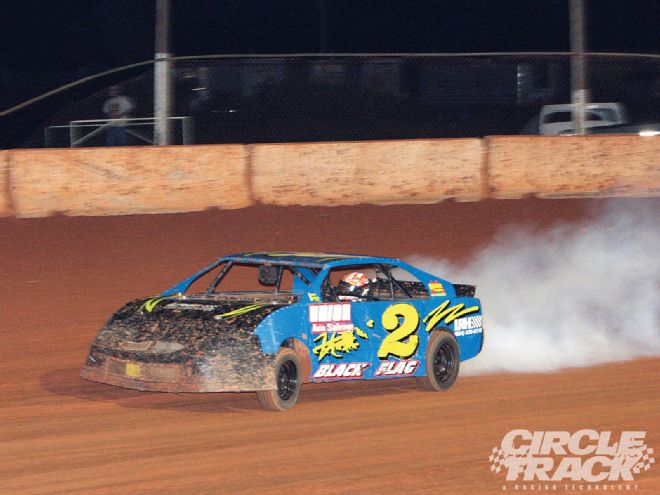
Lots of sports break down into three critical phases. Football has offense, defense, and special teams. Baseball has hitting, fielding, and pitching. In racing, it is essentially the engine, chassis, and driver. Maximize the performance of all three areas and wins will almost certainly follow.
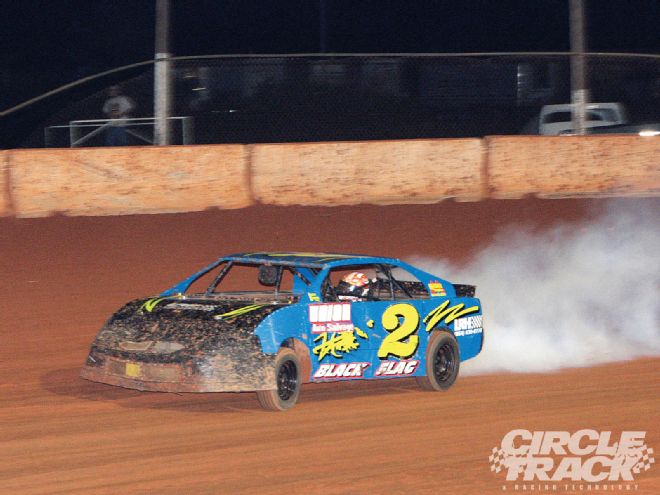 Engine problems are just a part of life in stock car racing, but the question is how quickly can you fix any problems that crop up so that they won't happen again?
Engine problems are just a part of life in stock car racing, but the question is how quickly can you fix any problems that crop up so that they won't happen again?
Most teams spend the majority of their time working on the chassis and have a pretty good handle on it. If not, scrape together every past issue of Circle Track you can get your hands on and study every article written by our own Bob Bolles. That will get you well on your way. The driver is a complete enigma. Nobody understands him, including his wife. So the best strategy there is to pray you get lucky. (Just kidding, that's an article for another day.) But it's the last third-the engine-that often leaves teams scratching their heads at the worst possible time.
The most common example is a team member picks up a new engine from the engine builder. The builder informs him that "it ran great on the dyno and should do you right." The engine builder even provides a dyno sheet to prove it. But when you get it in the car and take it to the track it behaves more like an ill-mannered child than a world-class sprinter. It makes no sense, and you end up wondering if your engine builder tricked you into buying a lemon.
If this describes a situation you have ever been in, don't worry, you aren't alone. There isn't an engine builder in the business who hasn't been cussed over a problem that he had nothing to do with. The problem to a balky engine often has a simple solution that's just been overlooked and has nothing to do with the engine itself. Inside your race car it is part of a very complex mechanical system where everything is dependent on something else. After all, it's not the heart's fault for being unable to pump oxygen-rich blood if your lungs are filled with pneumonia after you sat in the stands for an entire football game in January with your shirt off.
So in the interest of making your life a little easier, we've collected eight tips for things to check when your engine isn't running right-or to make sure you keep from blowing that expensive engine to smithereens. These were collected from engine builders who have seen them time and again from racers. Hopefully, these have never ruined a night of racing for you, and now they will never have to.
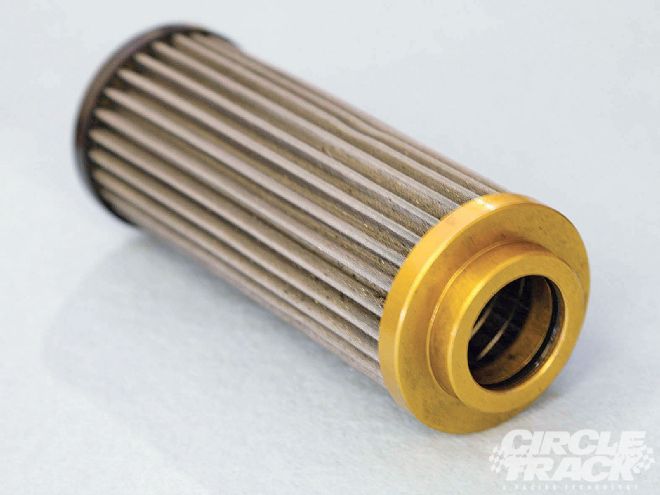 Filters are intended to work from the outside in. In other words, when you have a removable filter such as this one, always make sure to install it so that the dirty oil flows across the outside of the filter media and exits through the inside. If you install it backwards it can cause the pressure to back up and blow an oil pump seal.
Filters are intended to work from the outside in. In other words, when you have a removable filter such as this one, always make sure to install it so that the dirty oil flows across the outside of the filter media and exits through the inside. If you install it backwards it can cause the pressure to back up and blow an oil pump seal.
Cooling Issues
When the needle on the water temp gauge pegs the hot side and stays there, the answer is often fixed by pulling tape off the grille or some other way of improving flow through the radiator. But what do you do when the needle on the temp bounces back and forth and you can't tell what the temperature really is?
According to engine builder Keith Dorton of Automotive Specialists, that's a sign that you probably have air pockets in the cooling system. When the temp sensor for the gauge is surrounded by water, the gauge will read a relatively accurate temperature; but then when a pocket of air passes by the gauge's sensor, it will read lower.
The danger with this is when a bubble of air gets caught in the water jacket of the engine it can cause serious problems in the form of localized overheating. Localized overheating can result in one cylinder warping and ruining the piston rings. It can also lead to detonation in one cylinder, a sticking valve, and many other problems.
The best way to avoid this is to make sure you have no air at all in the cooling system. To do this you must have the radiator mounted so that the cap is higher than the engine's intake manifold. If this isn't possible, you can add a surge or expansion tank to the system so that the cap on it is higher than the engine. Fill the cooling system and then, with the cap off, crank the engine so that the water pump starts circulating coolant. As coolant moves through the engine and any pockets of air get pushed out, the coolant level will drop. Keep filling the radiator or expansion tank until the coolant level stays steady.
If, after flushing out all air pockets in the system, you still have trouble with air entering the cooling system, you might want to check to make sure you aren't somehow losing water. This can be from a defective pressure cap on the radiator or a leaking radiator hose. Often it won't show up until you are out on the racetrack when the water gets hot and the pressure builds in the cooling system-so it's hard to spot. One way to make sure this isn't happening is to use an oil pressure gauge plumbed into your cooling system so your driver will notice a drop in pressure.
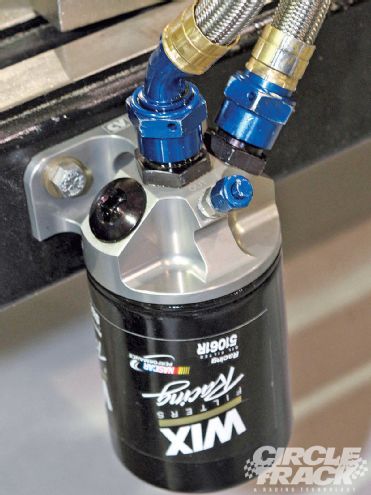 The same concept holds true for a standard canister filter mounted remotely. The inlet should always be on the outside edge of the remote filter mount, and the outlet is the fitting in the center.
The same concept holds true for a standard canister filter mounted remotely. The inlet should always be on the outside edge of the remote filter mount, and the outlet is the fitting in the center.
Watch Your Filters
Filters are often an afterthought with most teams. As long as they are clean you are good to go, right?
Not exactly. Dorton says he has seen many racers running an inline rebuildable oil filter have serious engine trouble because they had the filter element installed backward. Inline filters use a removable element that is cleanable to increase the useable life of the filter. The problem comes when the filter is removed for cleaning and then either reassembled with the element in the canister backward or with the canister itself turned the wrong way. When this happens the filter can't flow enough oil, the pressure backs up behind the filter and the end result is usually a blown seal on the pressure section of the external oil pump or a thrown oil pump drive belt. If you are running such a filter on a wet-sump engine, the excessive pressure buildup can lock up the oil pump and cause the engine to either strip the distributor gear or even break the oil pump driveshaft.
The key, Dorton says, is to understand how all filters work. They are designed for the oil to enter the filter on the outside of the element, flow through to the inside of the element, and then leave the filter. So, if you have a cone-shaped screen filter element, it should always be inserted so that the oil sees the pointed end first, flows through the screen and leaves though the big end of the cone.
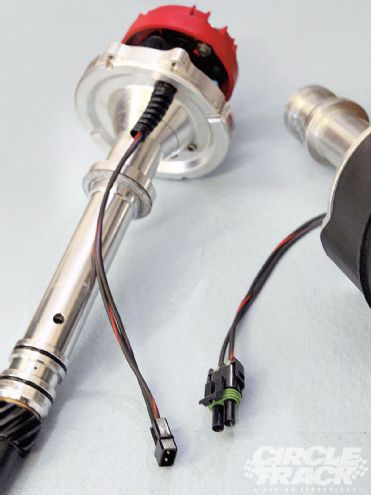 Many racers prefer to replace the standard plugs MSD provides (left) with weather-pack plugs which provide a little more protection from the elements (right). This is a good idea, just make sure you don't get the connections crossed, or else you will have ignition troubles.
Many racers prefer to replace the standard plugs MSD provides (left) with weather-pack plugs which provide a little more protection from the elements (right). This is a good idea, just make sure you don't get the connections crossed, or else you will have ignition troubles.
The same concept holds true if you are using a remote for a standard canister-style filter. The inlet hose should be connected to the fitting that's on the outside edge of the adaptor, and the outlet hose should be connected to the fitting in the center. Getting it backward can flush all the trash the filter has collected back through the engine. And you definitely don't want that.
Don't Switch the Leads
It's a good idea to make your race car's electrical system as weather-proof as possible. That's why many racers replace the standard connectors on their ignition system with weather pack connectors. These connectors are gasketed to seal out water, dirt, and other contaminants that can cause ignition troubles. But if you aren't careful, Dorton says you can get the wires switched, and that will leave you scratching your head wondering why your engine suddenly picked up a miss or simply isn't running like it used to.
One reason why switching the wires is so easy to do when installing new connectors is the two-wire lead from the 6AL box to the distributor on MSD systems is both wires are black. They just have a purple stripe on one and an orange stripe on the other. If you aren't paying attention, it's easy to get them backward. And the result is it will throw off the timing when the distributor sends the spark to the engine.
You can reset the timing by turning the distributor but this won't fix the misfiring problem that usually shows up in this situation. The test for this is to set your engine at its standard advance setting with a timing light. For this example, let's say 30 degrees before top dead center. Now, shut down the engine and turn it by hand until the pointer is lined up with the 30 degrees BTDC mark. Next, pull the distributor cap and take a look at how the rotor and pickup are lined up. If you have everything wired correctly, one of the paddles on the rotor should be lined up with the pickup, or slightly retarded. If the wires are switched, you will often find the pickup in between two of the paddles on the rotor. The current has trouble jumping the gap, and this is why the engine will miss or otherwise run poorly.
Warm It Up
Good race engines are built with tight tolerances to maximize the ability to use thinner oil, which sucks up less horsepower to pump throughout the engine. But as you know, oil changes viscosity as its temperature changes. And those tight tolerances are designed for motor oil at operating temp-180 degrees or more.
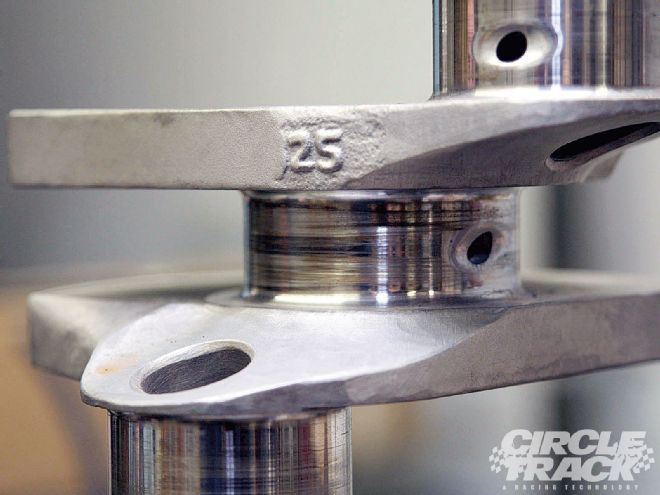 If the leads get crossed, the result is the ignition will try to fire when the paddles on the rotor aren't lined up with the pickup, as you can see here. This will lead to a misfire and lost power.
If the leads get crossed, the result is the ignition will try to fire when the paddles on the rotor aren't lined up with the pickup, as you can see here. This will lead to a misfire and lost power.
Most racers are aware that they need to properly warm up the oil before heading out on the track and nailing the throttle to the floor. If you don't, you could wind up with a spun bearing, a stuck valve or worse, because the oil pump can't move the thicker cold oil fast enough.
But Ken Troutman of KT Engine Development says he still often sees engines that are damaged by running at wide-open-throttle with oil that hasn't yet gotten to temperature. One of the problems, he says, is some teams mistakenly believe that if the water temperature gauge has reached the normal operating level, then the rest of the engine is properly warmed up.
That actually isn't the case, especially if you are running a separate oil cooler (one that's not built into the bottom of the radiator). If you have a heat exchanger that's built into the radiator, then oil temp will more closely follow water temp, but if you don't have one on your car, the water and oil can be at completely different temperatures. Running the engine at 2,500 rpm for 10 or 15 minutes will often warm the water while leaving the oil much cooler. The only reliable method is to make sure you have an oil temp gauge installed and then only make full-speed laps on the racetrack after the gauge reads that the oil has reached 180 degrees Fahrenheit or more.
Losing Oil Pressure
Both Dorton and Troutman mentioned phantom drops in oil pressure when we were collecting information for this story, so you can bet it's a problem many teams have encountered. The problem we are talking about here is when a race car will often show normal oil pressure levels at idle but then won't increase to racing oil pressure when the rpm levels are up. As a general rule, you will see 15 to 20 pounds of oil pressure at idle and then that will increase to at least 50 pounds at racing rpm.
 This is an example of a crank journal that has been damaged from something that happened to the oiling system. It likely was from oil starvation, which can happen if the engine is run at race rpm without properly heating the oil.
This is an example of a crank journal that has been damaged from something that happened to the oiling system. It likely was from oil starvation, which can happen if the engine is run at race rpm without properly heating the oil.
If your driver doesn't see the oil pressure gauge jump up the expected level once the car hits the track, the natural reaction is to blame the engine as faulty, but it can often be something completely different. One of the most common problems is the plumbing.
First, check to make sure you don't have any crimped oil lines, either as part of a dry-sump system or lines running to a remote oil filter. When several people are working on a car, it is often all too easy to crimp or pinch a line when installing a race engine. You should also check the quality of the oil lines, especially if you have any running near the headers.
Suction lines that are too close to the headers can have the rubber liner come loose from the wire braid. Then the rubber liner can suck closed on the racetrack without leaving a visual clue because the wire braid still looks good. If you spot this, replace and re-route the hose immediately away from the heat source. If you can't find a different way to route the hose, try adding a hose insulator to protect it from the heat. Also, make sure all of your fittings are made for high-performance engines.
Both engine builders mentioned that too often they see race engines fitted with plumbing fittings from the local hardware store. These are cheaper, but they just can't flow as much fluid through them. They will act fine when the engine is at idle but choke the motor of precious lubricant at racing rpms.
Finally, a drop in oil pressure for any reason is a quick way to blow up an expensive race engine. Yes, an oil pressure gauge will show you changes in oil pressure, but a race driver needs to keep his attention on the track, not watching his gauges. A good idea for a race team is to install an idiot light that will light up on the dash to warn the driver if the oil pressure drops too far. This will alert him in time so he can shut down the engine quickly and avoid an expensive repair.
Mystery Skips
We've already covered what happens if you get the leads to your distributor crossed, but there are also a number of other factors that can cause an engine to mysteriously start skipping or missing on the racetrack. And often, it's not the ignition system but something else.
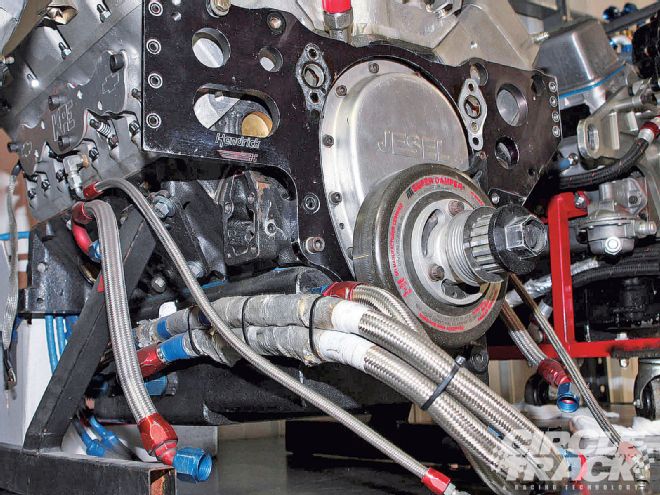 Be careful with external oil lines if you are racing a dry-sump engine. If these lines aren't properly routed they can get too close to the headers. The excessive heat from the headers can cause the rubber lining to weaken and suck closed in a vacuum line. A visual inspection won't turn up anything because the steel-braid sleeve on the outside will still look fine.
Be careful with external oil lines if you are racing a dry-sump engine. If these lines aren't properly routed they can get too close to the headers. The excessive heat from the headers can cause the rubber lining to weaken and suck closed in a vacuum line. A visual inspection won't turn up anything because the steel-braid sleeve on the outside will still look fine.
If you can't find the source of a miss on the racetrack, try looking at the other areas of the car's electrical system. A dying battery can often be a problem, even if you are running an alternator. And this one may not be obvious, but check the battery kill switch. Corrosion or bad contacts there can severely limit the amount of current getting through. The same thing goes with your electrical ground. Many racers use a couple different ground straps in the race car to try to avoid a problem here. Also, make sure your ground strap is connected to bare metal on the chassis. If it is attached over painted or powdercoated metal it simply can't work as efficiently.
Finally, Dorton recommends checking the wiring to the alternator. In order for the alternator to work as intended, it needs a pretty large cable to route the power it has generated through. Standard electrical wire like you used for the ignition switch simply isn't large enough. Dorton says the cable should be 1/4- to 3/8-inch thick and look more like a small battery cable than standard electrical wiring.
Poor Fuel Mileage
Most race classes don't require pit stops for refueling under green, but fuel mileage often does come into play whenever a track has extra-lap features, or the big-money races at the end of the season that can be 100 laps or more. And nothing can be more frustrating than running out of fuel when you are running well.
The first reaction normally is to blame the carburetor for being poorly tuned and extra thirsty. But before you round up an angry mob to scare the pants off of your carb tuner, take a moment to make sure you aren't leaving fuel in your race car. This requires pulling your fuel cell apart to make sure the pickup is situated correctly in the bottom of the cell.
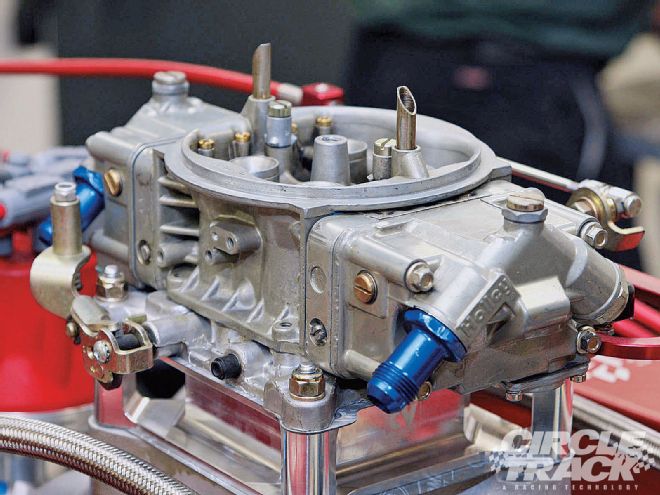 See those posts sticking up from the carburetor? Those are the vent tubes, and they have to be able to draw air through them in order for the carburetor to work correctly. Make sure you have at least 1/2-inch of clearance between the top of the vent tubes and the bottom of the air cleaner lid.
See those posts sticking up from the carburetor? Those are the vent tubes, and they have to be able to draw air through them in order for the carburetor to work correctly. Make sure you have at least 1/2-inch of clearance between the top of the vent tubes and the bottom of the air cleaner lid.
Sometimes, especially when repacking the cell, the pickup can get moved around or a chunk of foam can get underneath the pickup so that you run "dry" when there is still a gallon or two of fuel still in the fuel cell. Also, check your rule book and make sure you are using the largest fuel line, fuel filter, and fuel filler line allowed. Dorton says that using a No. 12 fuel line from the fuel cell to the fuel pump instead of a No. 6 can get you an extra 1/2 quart or more of fuel, which can be the difference between a strong finish and getting pushed back to the pits.
Carburetor Clearance
While we are talking about fuel systems, let's pick up on a problem that actually does involve the carb. One mistake some racers can make is to put the carburetor on the intake, make sure everything works and the throttle doesn't hang up, plop on the air cleaner, and then forget about it.
And there is actually a critical clearance between the carburetor and the top of the air cleaner that you must be aware of. If the air cleaner lid is too close to the top of the carburetor, it can block the inlets for the vent tubes. Generally, the vent tubes need at least 1/2-inch of clearance or it can cause the engine to stumble at wide open throttle. If this is happening to you, try a taller air-cleaner element and see if it fixes the problem.
There you have it; eight engine tips to keep you on track and out of trouble.